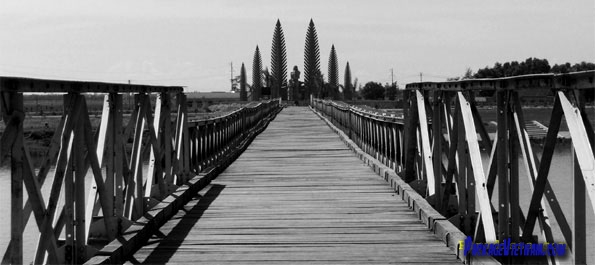
DMZ (Demilitarized zone)
Related Links
According to the Geneva Accord, Vietnam was temporarily divided into 2 zones with the provisional military demarcation line between North and South Vietnam was the vicinity of 17°N latitude from the mouth of the Ben Hai River (Cua Tung) and the course of that river. The Demilitarized Zone was to be created on either side of the demarcation line to the width of not more than 5km to act as a buffer zone. Vietnam was to become an independent nation. Elections were to be held in July 1956, under international supervision, to choose a government for Vietnam.
The temporary division of Vietnam would turn out later to be 20 years; the Demilitarized Zone would be the most destroyed area during the war; the election would simply never come as planned in 1956. The Geneva Accord was simply meant to be on paper only.
Nowadays traveling in the DMZ, the visitor can still visit the live scars of war and learn about the process of bringing the 2 pieces of this country together again.
Travel and Tours
The DMZ is approximately 75km north of Hue Imperial Citadel and 580km south of Ha Noi. From Ha Noi you can take an overnight train for Dong Ha Town or from Hue you can take a day tour to the DMZ.
Taking a day tour of the DMZ from Hue is an experience back in times. It takes you about an hour to get to Quang Tri where you can take a glimpse of the grim ancient citadel - the witness of the most fierce battles between 1967 and 1972: dreary crumbled walls, bullet holes and bomb craters.
Then you continue further onto Dong Ha Town, the major supply base for the US forces in the war. It would be no surprise if you see more and more ragged amputees hobbling around on crutches in town. The bullet holes left here and there too vivid to be forgotten. Out in the paddy fields, bomb craters now are used as reservoirs or fish farms by the local communities...
Passing Dong Ha, you turn onto Road No.9 running across the country to the Lao Border. This road was heavily bombed in the war; there was also a huge amount of defoliant dropped down here to stop the flows of enforcements moving from North Vietnam into the South along Ho Chi Minh Trails. If you notice you'll find that there are not many trees grown around here, except for the green bushes.
On Road No.9, you can sample the Dakrong Bridge which received 'special treatments' from the US Air Force since it was an important point of the legendary trails in the war. On the road, you can also take a look at the Rockpile Firebase, a helicopter base sitting on top of a hill commanding a wide view of the surrounding areas. This was one base of the chain of fire bases known as McNamara Line trying to uncover all possible movement signals in its range and stop all those movements once caught.
The trip continues past Lao Bao Border check point into a valley called Khe Sanh which the Vietnamese troops besieged for 77 days in 1967-1968. Not much left nowadays, all just covered with coffee plantations. Still you can take a deep breath in and imagine that, back in times, there were fierce battles here once!...
Leaving the Khe Sanh Valley, you travel back past Dong Ha Town to the demarcation line: the Ben Hai River and Hien Luong Bridge. On the northern riverside you'll notice Ho Chi Minh's Statements which have been proved to be the truth in the few thousand years of the Vietnamese history:"There's only one country of Vietnam, there's only one people of Vietnamese; Rivers may be dried out and mountains may be completely eroded, but those self-evident truths are unchangeable!"
Passing the Ben Hai historic River, you travel further to Vinh Moc where you'll creep your way down the dark tunnels in which the locals lived their life in the war. The tunnels were also where many babies were born during the annihilation bombardments dictating this country's determination to dream on...
On the way back you may want to spend a few minutes for silence at the Truong Son National Cemetery where thousands of men and women of Vietnam, most of them in their early twenties, sacrificed in the war. In the mist of late afternoon and shrouded in incense smoke, ranges of tombstones line their way km further and further...
Accommodation
Currently accommodations at the DMZ are only simple hotels in Dong Ha Town. For luxurious accommodations, you may want to head further to Quang Binh (approximately 100km north of Dong Ha) where you can get a beach resort and spa at Nhat Le Beach; or you may want to head further south to Hue where many good hotels are found.
Vietnam Travel Guides
- Activities
- Arts & Entertainment
- Bac Kan
- Bac Lieu
- Bac Ninh
- Battlefields
- Ben Tre
- Buon Ma Thuot
- Ca Mau
- Can Tho
- Cao Bang
- Cat Ba Island
- Chau Doc
- Climate
- Cu Chi Tunnel
- Da Lat
- Da Nang
- Dangers & Annoyances
- Economy
- Embassies & Consulates for Vietnam
- Embassies & Consulates of Vietnam
- Festivals & Events
- Food & Drinks
- Geography
- Gia Lai



 Print
Print 




